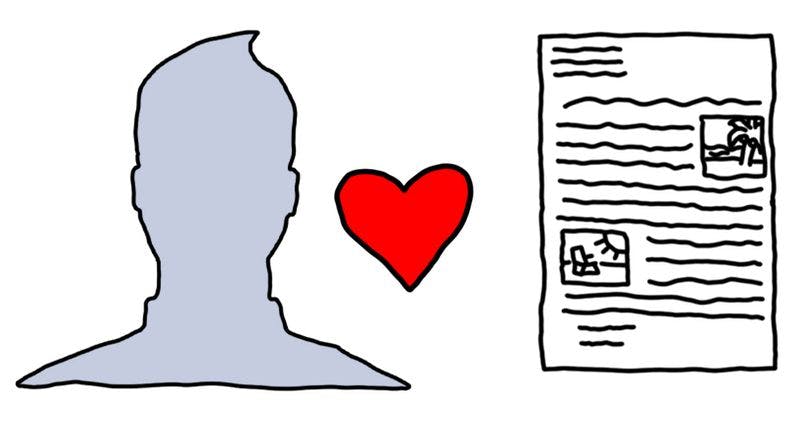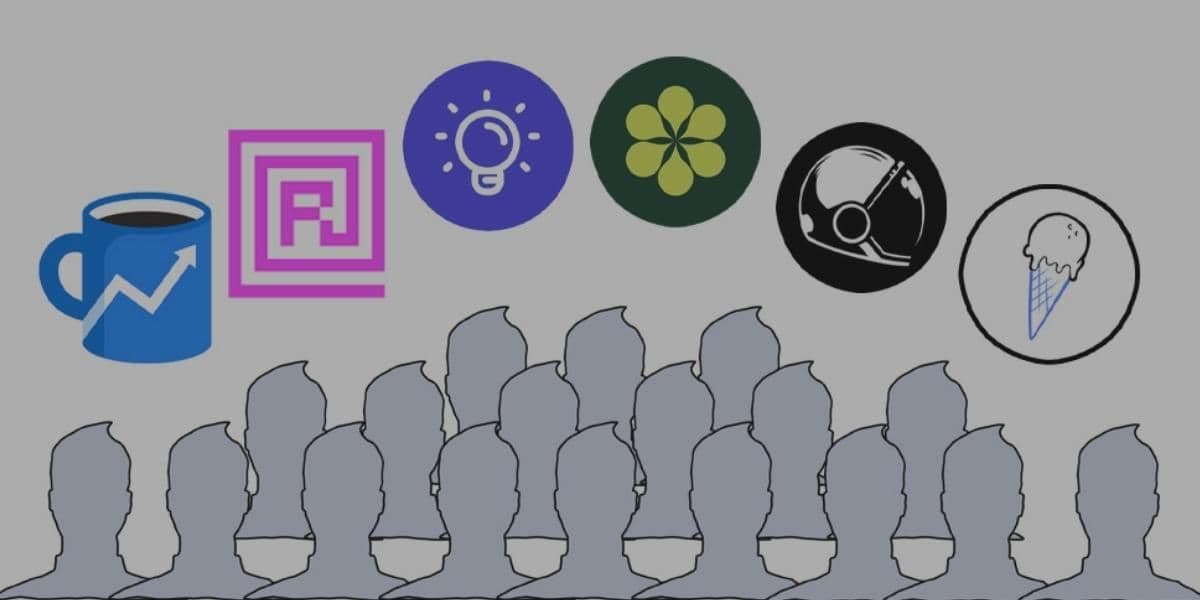7 Ways To Get Your First 1000 Newsletter Subscribers
It seems like everyone is launching a newsletter these days.
And for good reason, newsletters are like written tv-shows in your inbox.
Meaning, if you nail it — your newsletter becomes a part of someone's day, and something that individual looks forward to.
In the same way that people drop everything, get their glass of wine, and watch the Bachelor or Bachelorette on Tuesdays at 8 p.m. ET.
In the newsletter world, for example, 2PM subscribers look forward to their newsletter that drops every Monday at 2PM.
On my end, I aim to make Thursday's a staple in your content diet with my Thursday Teardown.
So, why?
Newsletters build bridges.
But a specific bridge that's hard to replicate.
Let me explain...
The Social Media Bridge
Build an audience on social media (Twitter, Instagram, TikTok, etc) and you build a bridge to awareness.
Social media channels have distribution built-in — meaning it can give your content wings to travel from person to person.
A recipe for awareness.
I like to define awareness as "someone knowing or recognizing your brand.
They are aware it exists.
The extent to which consumers are familiar with the distinctive qualities or image of a particular brand of goods or services. - Dictionary
But because social media platforms are controlled by algorithms, your awareness is capped by the algorithm.
On the other end, they give you free distribution.
And a bridge to awareness and attention which gives you leverage to build more meaningful bridges.
The Newsletter Bridge

And newsletters, build bridges to affinity.
I define affinity as "someone loving your brand."
Where an individual feels connected to your brand in a way where they make it a part of their life, day, habits, etc.
Brand affinity is the most enduring and valuable level of a relationship between a business and consumer based on the mutual belief that they share common values. - Wistia
And affinity is fueled by advocacy.
This means people connecting to your brand's purpose, personality, and perception.
So, how does a newsletter drive affinity?
Five things stand out:
- Newsletters are centered around one theme
- Newsletters are binge-worthy
- Newsletters are value-centric
- Newsletters have a consistent schedule
- Newsletters are personal (They live in your sacred inbox)
Combining all five elements and you have the potential to create brand advocates.
Advocates that will stay around for a lifetime.
And The Proof Is In The Pudding
More and more companies are coming to grips that they need to act like a media company or build a media arm.
A few notable examples:
- HubSpot acquiring The Hustle
- Penn acquiring Barstool Sports
- Stripe acquiring Indie Hackers
- Robinhood acquiring MarketSnacks
- Mailchimp acquiring Courier
Because this all proves one thing, that it's not enough to have an audience — you must also have a loyal audience.
And that's an asset that's hard to build.
This takes us back to newsletters and how to start building a loyal audience.
Your First 1000 Subscribers
I believe anyone can get their first 100 subscribers fairly easily. Simple things like posting to social, asking colleagues to subscribe or share, inviting family and friends...
But 1000 subscribers is a larger barrier.
To put it into perspective, imagine yourself speaking at a conference with 1000 people in attendance.
That's a big deal and would really test your antiperspirant deodorant.
And takes a strategic approach to get there.
Because your first 1000 subscribers builds the base that influences how you scale.
How 7 Newsletters Got Their First 1000 Subscribers
So, I interviewed, texted, and Dm'd seven different founders and creators to find out how they got their first 1000 subscribers.
And nearly everyone had a different answer.
1. Alex Lieberman - MorningBrew
Alex Lieberman is the co-founder of Morning Brew, a newsletter with over 2.5M subscribers where they curate the best business and tech news.
But, for the first two years, it was a side hustle while he attended the University of Michigan.
And so, Alex turned to his college campus to get his first 1000 subscribers
He reached out to every business class and club and asked the professor or president for the chance to pitch their newsletter for three minutes.
After the pitch, Alex would pass out a small piece of paper to students to fill out their names and email.
Alex would then manually add these emails to his email service provider.
And this is actually how Morning Brew got their first 2000 subscribers.
2. Chris Toy - Raisin Bread by MarketerHire
Chris Toy is the co-founder of MarketerHire and also has spent 20 years marketing startups and Fortune 500 companies.
MarketerHire is a marketplace to hire vetted marketers.
When he launched MarketerHire, he knew he had to launch a newsletter knowing it would attract top-tier marketing talent.
And so they did within 3 months of launching, MarketerHire.
Chris said that getting their first 1000 subscribers fell into three buckets.
- First, they put in a ton of effort into driving traffic to MarketerHire and optimized their blog, platform, and content to convert traffic into email subscribers.
- Secondly, it was creating a great newsletter that was designed to be chopped up for social media.
- With this, he and colleagues were able to quickly take clips, sound bites, and micro-pieces of content to share quickly.
- Instead, of trying to build an entirely new following for RaisinBread, the MarketerHire team used LinkedIn and their existing connections and followers to drive subscriber growth.
- With this, he and colleagues were able to quickly take clips, sound bites, and micro-pieces of content to share quickly.
- Lastly, was word-of-mouth. MarketerHire put an emphasis on creating their newsletter in a way that you wanted to share it with friends or co-workers.
Now, MarketerHire is well over 30,000 subscribers and continues to take Twitter by storm.
3. Mario Gabriele - The Generalist
Mario Gabriele is the founder of The Generalist where they help you understand how technology is changing the world.
And just recently, The Generalist reached 50,000 subscribers.
So, I asked Mario how he got his first 1000 subscribers for the Generalist.
And it came down to one principle and two tactics.
First, the principle.
Mario says, "truthfully, I believe the only reliable way to grow an audience is to create something people want and share it. If you do that regularly, you will grow."
And now the tactics:
- First, Mario added the generalist to his email signature which he says "prompted people to ask about it and sign up."
- Secondly, he emailed or DM’d the presidents of different PEVC clubs, sharing the newsletter and asking if they’d share it. A few of them dropped it into their club’s Slack, encouraging members to sign up.
- Mario did this because he had a thesis that the newsletter would be useful to MBA students trying to break into VC.
Even though his tactics worked and helped him reach 1000 subs, Mario says, "I strongly believe the best thing you can do is much simpler, and much harder: hone your practice, share until it hurts, and then take the feedback onboard to get better. That’s it."
4. Ari Lewis - PayLoad
Payload is a newsletter that covers the business and policy of space.
Ari Lewis, the co-founder of PayLoad said he would use LinkedIn's advanced search and find individuals on LinkedIn who worked in the space industry.
He would then DM them personally and tell them about PayLoad and shoot them over the link to subscribe if they were interested.
He used this exact tactic to get hundreds of new, and interested subscribers for PayLoad.
Ari also said Twitter was an integral part of acquiring their first 1000 subs. He created an account for PayLoad and shared micro pieces of news that would later be covered in the newsletter. Because Ari has an audience of 11k+ he would R/T PayLoad's tweets to gain early traction.
5. Matthew O'brien - The Green Paper
Matthew O'brien is the founder of The Green Paper, now a part of WorkWeek where he breaks down the world of cannabis, industry news, and the best data on the global cannabis industry.
For Matthew, his first 250 subs were easy. He was active on LinkedIn for 8 months prior to releasing his newsletter. So, when it dropped, much of his audience carried over from LinkedIn to his newsletter.
But at 250 subs, growth plateaued. To surge growth again, Matthew knew he had to get people to share the content he was creating.
So, he found Cannabis industry leaders who were active on social media and started interviewing them for pieces in his newsletter, and encouraged them to share it with their audience.
This strategy helped him grow from 250 subscribers to 1000 subscribers fairly quickly.
6. Andrew Gazdecki - Bootstrappers by MicroAcquire
Andrew Gazdecki is the founder of MicroAcquire which launched its own newsletter and blog called Bootstrappers where they share the stories, strategies, and tactics behind bootstrapped startups.
First some stats:
- 0 to 10 articles in 30 days
- 0 to 10,000 subs in less than 3 months
So, how?
It started with Beef Marketing. Essentially, picking a fight with TechCrunch via Twitter. Where TechCrunch only shared the news on venture-funded startups, Bootstrappers did the opposite and shared the stories of bootstrapped startups.
And brought that to the limelight on Twitter, sharing DMs, tweets, and stories from founders who weren't getting coverage from TechCrunch.
To, fix this Andrew created a form for founders who felt disrespected by TechCrunch to fill out so they could be featured in Bootstrappers.
The entire move went viral throughout tech Twitter.
Secondly, word-of-mouth. "Nearly all" founders who were featured in Bootstrappers shared their articles all over social media.
Andrew says they share the articles "because they're proud of the style in which we write them, we tell the ups & downs, and make them sound like the rockstars of the startup world."
Lastly, social media marketing. They would turn these founder stories into threads and many of them went viral garnishing millions of impressions. These viral threads surged growth for Bootstrappers.
7. Edwin Dorsey - The Bear Cave
Edwin Dorsey is the founder of The Bear Cave where he exposes bad companies on a weekly basis.
Edwin first noted that Twitter is instrumental to his early growth and stated that his first 200 subscribers came from his launch tweet.
He had 2000 followers at the time.
But going from 200 to 1000 subscribers came down to four strategies:
- Edwin would distill his newsletter into Twitter threads and link his newsletter at the end.
- Anytime a thread gained traction he would get a new surge of subscribers.
- Edwin made a list of every college investing club in the U.S. and cold emailed all of them to tell them about his newsletter.
- He says, "Students are great early subscribers because they are hyper-social and share content."
- Edwin would DM major journalists and big accounts on Twitter DM in his niche to tell them about his newsletter and some of them ended up sharing it.
- Fourth, Edwin spent two days personally DMing all of his 2,000 Twitter followers asking them to sign up for his newsletter.
- He says, "That took a lot of time but got an extra 400 subscribers."
- Fifth, Edwin said that he "got invited on small podcasts and accepted every interview" which helped spark growth from carryover.
Overall, it took Edwin three months to get his first 1000 subscribers for The Bear Cave.
Biggest Takeaways
After talking to various founders and creators, I wanted to compile some of the best learnings in one place.
- Collaborating with other creators or giving industry leaders a platform to speak will quickly expose you to larger audiences.
- Schedule ad swaps with other newsletters. With this, you're going to where other newsletter readers are already hanging out.
- Find existing internet communities like IndieHackers, Facebook Groups, Slack Channels, or Discords with existing members relative to your domain and figure out how to provide value there. Then politely ask for members to subscribe to your newsletter.
- Your social media efforts will convert better if you give your audience a friction-free way to subscribe. For example, adding a link to a viral tweet or adding a push to your LinkedIn content.
- Say yes to nearly every podcast or interview to tap into existing audiences eager to find more content around a particular subject.
- Make it friction-free and obvious to share your newsletter via social or by forwarding it.
- Add a referral program early on. Your referral program can be an instrument to get new subscribers to refer more subscribers. Find a way to provide even more value upfront that motivates them to take action.
- Find leaders or individuals of real-world communities and organizations and ask to either talk to the group or share your content/newsletter with them.
- Optimize your blog or website not only for traffic but to convert traffic into subscribers. Whether adding a newsletter plugin\ for each article, adding a lead magnet, or adding an opt-in form to your footer.
- Build a community first, then use the community to bridge members into subscribers.
- Cocreate with your audience so that they feel a deeper connection to your newsletter.
- Find low-lift ways to get more subscribers that compound over time, like adding your newsletter to your email signature.
That's it for this edition! I hope this helped. And if you have any questions, thoughts, stories, or tips then you can message me here on Twitter.


